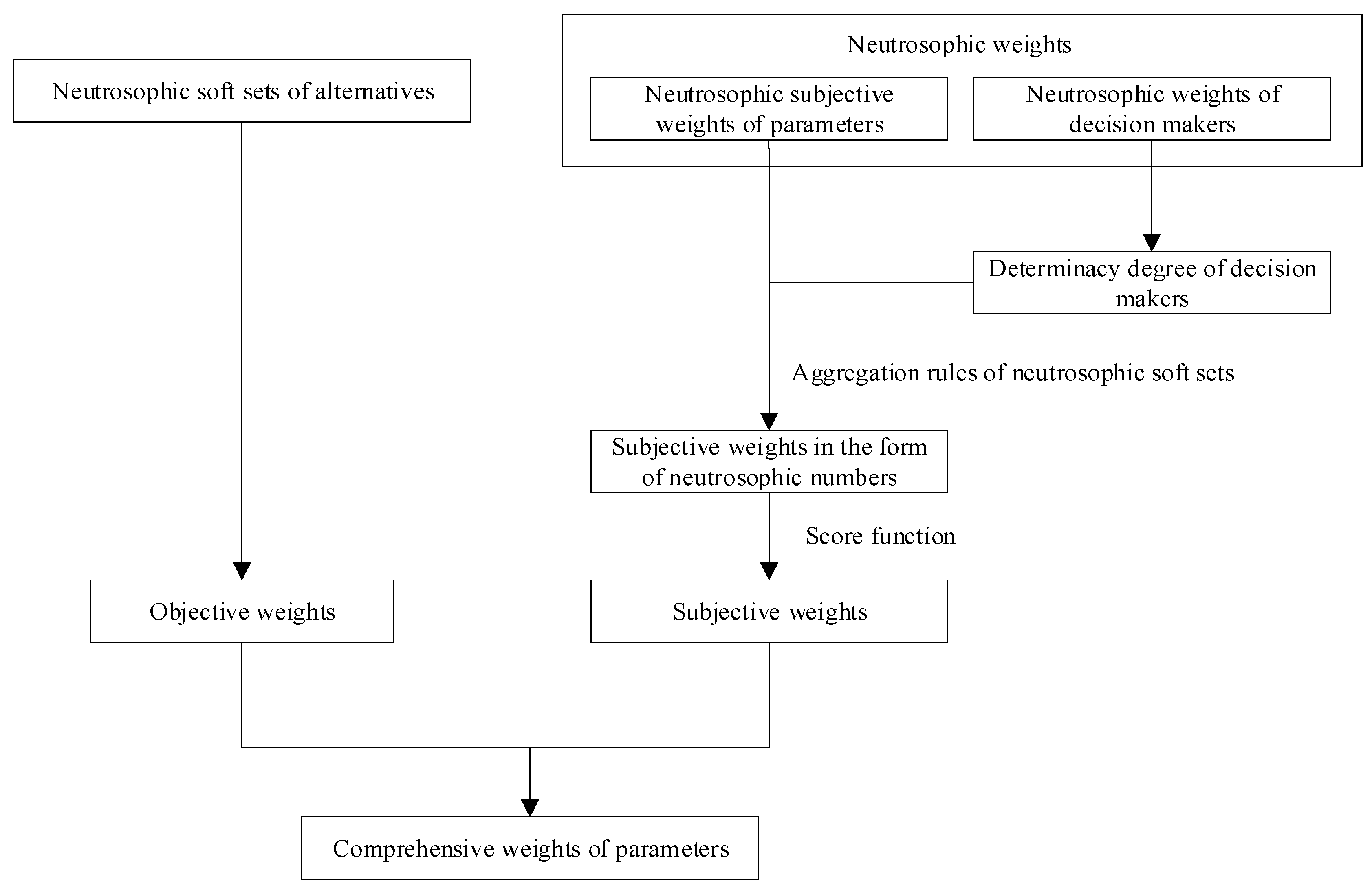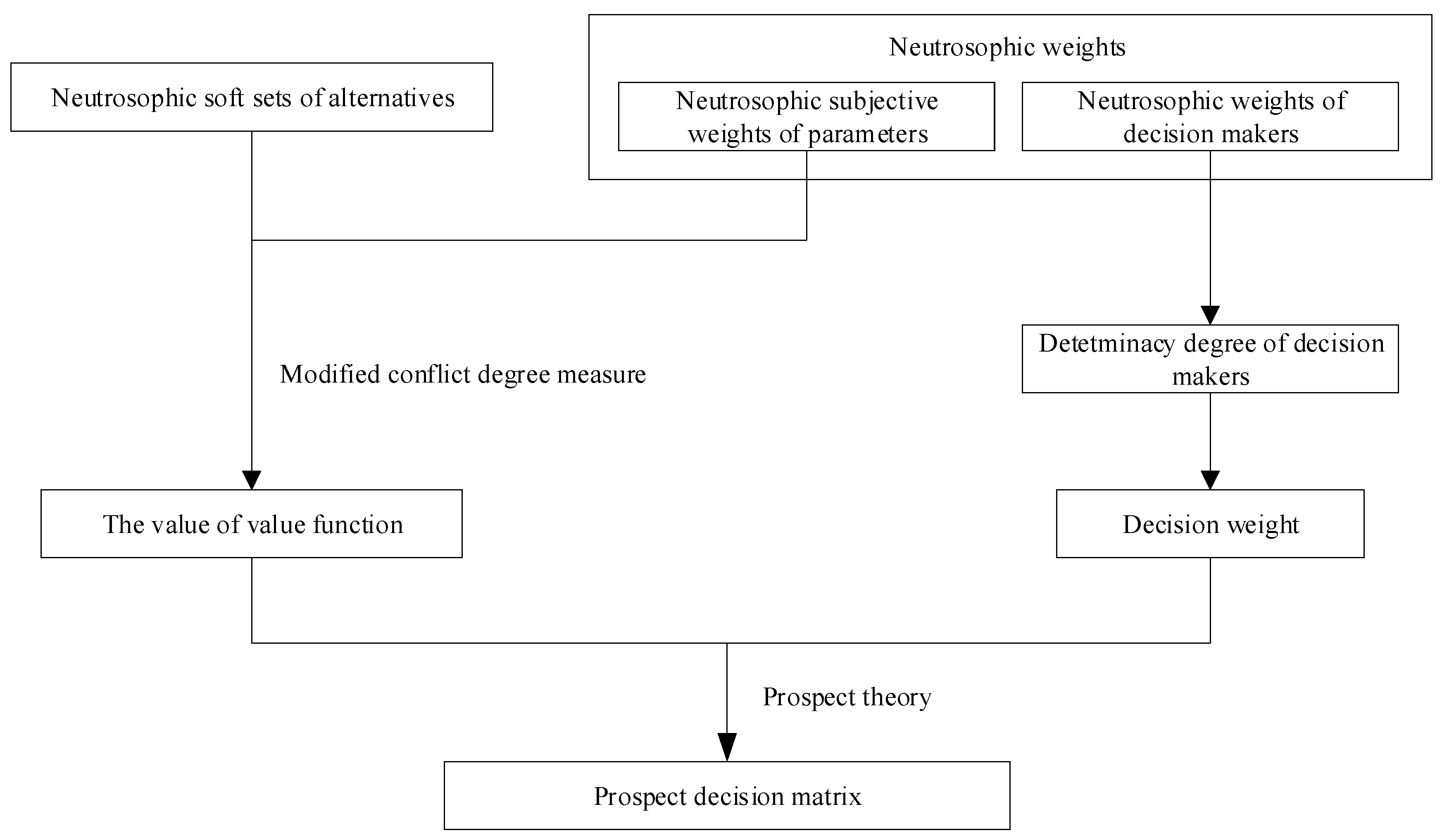Algorithm for Neutrosophic Soft Sets in Stochastic Multi-Criteria Group Decision Making Based on Prospect Theory
Abstract
1. Introduction
2. Preliminaries
2.1. Neutrosophic Soft Sets
- If,is superior toand it can be denoted by;
- If,,is superior toand is denoted by;
- If,and,is superior toand is denoted by;
- If,and,is equal to, denoted by.
2.2. Prospect Theory
3. The Measures of Determinacy Degree and Conflict Degree and Neutrosophic Soft Set Aggregation Rules
3.1. The Measures of Determinacy Degree and Conflict Degree
3.2. Aggregation Rules of a Neutrosophic Soft Set
4. Algorithm for Neutrosophic Soft Sets in Stochastic Multi-Criteria Group Decision Making Based on Prospect Theory
4.1. Problem Description
4.2. Determining the Determinacy Degree of Decision Makers
4.3. Calculating the Comprehensive Weights of Parameters
4.3.1. Computing the Subjective Weights
4.3.2. Obtaining the Objective Weights: Information Entropy Method
4.3.3. Calculating the Comprehensive Weights
4.4. Computing the Comprehensive Prospect Values
4.4.1. Constructing the Prospect Decision Matrix
4.4.2. Computing the Comprehensive Prospect Values
4.5. Algorithm for Neutrosophic Soft Sets in Stochastic Multi-Criteria Group Decision Making Based on Prospect Theory
| Algorithm 1: Neutrosophic soft sets in stochastic multi-criteria group decision making based on the prospect theory |
| Step 1: Input a neutrosophic set, which represents neutrosophic weights of decision makers and two neutrosophic soft sets, including alternatives description as shown in Table 1 and neutrosophic subjective weights of parameters evaluated by decision makers. Step 2: Normalize the neutrosophic soft sets of alternatives as follows: Step 3: Compute the determinacy degree vector of decision makers by Equation (8); Step 4: Construct the prospect decision matrix based on Equation (20). Step 5: Obtain the comprehensive weight vector by Equation (18); Step 6: Calculate the comprehensive prospect value Vi for each alternative through Equation (23). Step 7: Make a decision by ranking alternatives based on comprehensive prospect values. |
5. An Application of the Proposed Algorithm
5.1. Example Analysis
5.2. Comparative Analysis
6. Conclusions
Author Contributions
Funding
Acknowledgments
Conflicts of Interest
References
- Zadeh, L.A. Fuzzy sets. Inf. Control 1965, 8, 338–353. [Google Scholar] [CrossRef]
- Pawlak, Z. Rough sets. Int. J. Comput. Inf. Sci. 1982, 11, 341–356. [Google Scholar] [CrossRef]
- Gorzałczany, M.B. A method of inference in approximate reasoning based on interval-valued fuzzy sets. Fuzzy Sets Syst. 1987, 21, 1–17. [Google Scholar] [CrossRef]
- Molodtsov, D. Soft set theory-first results. Comput. Math. Appl. 1999, 37, 19–31. [Google Scholar] [CrossRef]
- Aktaş, H.; Çağman, N. Soft sets and soft groups. Inf. Sci. 2007, 177, 2726–2735. [Google Scholar] [CrossRef]
- Acar, U.; Koyuncu, F.; Tanay, B. Soft sets and soft rings. Comput. Math. Appl. 2010, 59, 3458–3463. [Google Scholar] [CrossRef]
- Min, W.K. A note on soft topological spaces. Comput. Math. Appl. 2011, 62, 3524–3528. [Google Scholar] [CrossRef]
- Çağman, N.; Karataş, S.; Enginoglu, S. Soft topology. Comput. Math. Appl. 2011, 62, 351–358. [Google Scholar] [CrossRef]
- Danjuma, S.; Ismail, M.A.; Herawan, T. An alternative approach to normal parameter reduction algorithm for soft set theory. IEEE Access 2017, 5, 4732–4746. [Google Scholar] [CrossRef]
- Yuksel, S.; Dizman, T.; Yildizdan, G.; Sert, U. Application of soft sets to diagnose the prostate cancer risk. J. Inequalities Appl. 2013, 2013, 229. [Google Scholar] [CrossRef]
- Kamacı, H.; Atagün, A.O.; Sönmezoğlu, A. Row-products of soft matrices with applications in multiple-disjoint decision making. Appl. Soft Comput. 2018, 62, 892–914. [Google Scholar] [CrossRef]
- Fatimah, F.; Rosadi, D.; Hakim, R.B.F.; Alcantud, J.C.R. N-soft sets and their decision making algorithms. Soft Comput. 2018, 22, 3829–3842. [Google Scholar] [CrossRef]
- Feng, F.; Li, C.; Davvaz, B.; Ali, M.I. Soft sets combined with fuzzy sets and rough sets: A tentative approach. Soft Comput. 2010, 14, 899–911. [Google Scholar] [CrossRef]
- Maji, P.K.; Biswas, R.; Roy, A.R. Fuzzy Soft Sets. J. Fuzzy Math. 2001, 9, 589–602. [Google Scholar]
- Jiang, Y.; Tang, Y.; Chen, Q. An adjustable approach to intuitionistic fuzzy soft sets based decision making. Appl. Math. Model. 2011, 35, 824–836. [Google Scholar] [CrossRef]
- Smarandache, F. A Unifying Field in Logics. Neutrosophy: Neutrosophic Probability, Set and Logic; American Research Press: Rehoboth, DE, USA, 1999. [Google Scholar]
- Maji, P.K. Neutrosophic soft set. Comput. Math. Appl. 2013, 45, 555–562. [Google Scholar] [CrossRef]
- Sahin, R.; Küçük, A. Generalised Neutrosophic Soft Set and its Integration to Decision Making Problem. Appl. Math. Inf. Sci. 2014, 8, 2751. [Google Scholar] [CrossRef]
- Deli, I.; Broumi, S. Neutrosophic soft matrices and NSM-decision making. J. Intell. Fuzzy Syst. 2015, 28, 2233–2241. [Google Scholar] [CrossRef]
- Deli, I. Interval-valued neutrosophic soft sets and its decision making. Int. J. Mach. Learn. Cybern. 2017, 8, 665–676. [Google Scholar] [CrossRef]
- Karaaslan, F. Possibility neutrosophic soft sets and PNS-decision making method. Appl. Soft Comput. 2017, 54, 403–414. [Google Scholar] [CrossRef]
- Karaaslan, F. Correlation coefficients of single-valued neutrosophic refined soft sets and their applications in clustering analysis. Neural Comput. Appl. 2017, 28, 2781–2793. [Google Scholar] [CrossRef]
- Uluçay, V.; Şahin, M.; Hassan, N. Generalized neutrosophic soft expert set for multiple-criteria decision-making. Symmetry 2018, 10, 437. [Google Scholar] [CrossRef]
- Al-Quran, A.; Hassan, N.; Marei, E. A Novel Approach to Neutrosophic Soft Rough Set under Uncertainty. Symmetry 2019, 11, 384. [Google Scholar] [CrossRef]
- Peng, X.; Liu, C. Algorithms for neutrosophic soft decision making based on EDAS, new similarity measure and level soft set. J. Intell. Fuzzy Syst. 2017, 32, 955–968. [Google Scholar] [CrossRef]
- Abu Qamar, M.; Hassan, N. Entropy, measures of distance and similarity of Q-neutrosophic soft sets and some applications. Entropy 2018, 20, 672. [Google Scholar] [CrossRef]
- Kahneman, D.; Tversky, A. Prospect theory: An analysis of decisions under risk. Econometrica 1979, 47, 263–291. [Google Scholar] [CrossRef]
- Peng, X.; Yang, Y. Algorithms for interval-valued fuzzy soft sets in stochastic multi-criteria decision making based on regret theory and prospect theory with combined weight. Appl. Soft Comput. 2017, 54, 415–430. [Google Scholar] [CrossRef]
- Haibin, W.; Smarandache, F.; Zhang, Y.; Sunderraman, R. Single Valued Neutrosophic Sets. Multispace Multistruct. 2010, 4, 410–413. [Google Scholar]
- Liu, C.; Luo, Y.S. Correlated aggregation operators for simplified neutrosophic set and their application in multi-attribute group decision making. J. Intell. Fuzzy Syst. 2016, 30, 1755–1761. [Google Scholar] [CrossRef]
- Ye, J.; Du, S. Some distances, similarity and entropy measures for interval-valued neutrosophic sets and their relationship. Int. J. Mach. Learn. Cybern. 2019, 10, 347–355. [Google Scholar] [CrossRef]
- Sahin, R.; Küçük, A. On similarity and entropy of neutrosophic soft sets. J. Intell. Fuzzy Syst. 2014, 27, 2417–2430. [Google Scholar]
- Alfaro-García, V.G.; Merigó, J.M.; Gil-Lafuente, A.M.; Kacprzyk, J. Logarithmic aggregation operators and distance measures. Int. J. Intell. Syst. 2018, 33, 1488–1506. [Google Scholar] [CrossRef]
- Choi, S.H.; Jung, S.H. Similarity Analysis of Actual Fake Fingerprints and Generated Fake Fingerprints by DCGAN. Int. J. Fuzzy Log. Intell. Syst. 2019, 19, 40–47. [Google Scholar] [CrossRef]
- Biswas, P.; Pramanik, S.; Giri, B.C. Entropy based grey relational analysis method for multi-attribute decision making under single valued neutrosophic assessments. Neutrosophic Sets Syst. 2014, 2, 102–110. [Google Scholar]
- Wu, K.; Jin, J. Attribute recognition method of regional ecological security evaluation based on combined weight on principle of relative entropy. Sci. Geogr. Sin. 2008, 28, 754–758. [Google Scholar]
- Jiang, W.; Zhang, Z.; Deng, X. Multi-Attribute Decision Making Method Based on Aggregated Neutrosophic Set. Symmetry 2019, 11, 267. [Google Scholar] [CrossRef]



| … | ||||
| … | ||||
| … | ||||
| … | ||||
| … | ||||
| … | ||||
| … | ||||
| … | ||||
| … | ||||
| … | ||||
| … | ||||
| … | ||||
© 2019 by the authors. Licensee MDPI, Basel, Switzerland. This article is an open access article distributed under the terms and conditions of the Creative Commons Attribution (CC BY) license (http://creativecommons.org/licenses/by/4.0/).
Share and Cite
Dong, Y.; Hou, C.; Pan, Y.; Gong, K. Algorithm for Neutrosophic Soft Sets in Stochastic Multi-Criteria Group Decision Making Based on Prospect Theory. Symmetry 2019, 11, 1085. https://doi.org/10.3390/sym11091085
Dong Y, Hou C, Pan Y, Gong K. Algorithm for Neutrosophic Soft Sets in Stochastic Multi-Criteria Group Decision Making Based on Prospect Theory. Symmetry. 2019; 11(9):1085. https://doi.org/10.3390/sym11091085
Chicago/Turabian StyleDong, Yuanxiang, Chenjing Hou, Yuchen Pan, and Ke Gong. 2019. "Algorithm for Neutrosophic Soft Sets in Stochastic Multi-Criteria Group Decision Making Based on Prospect Theory" Symmetry 11, no. 9: 1085. https://doi.org/10.3390/sym11091085
APA StyleDong, Y., Hou, C., Pan, Y., & Gong, K. (2019). Algorithm for Neutrosophic Soft Sets in Stochastic Multi-Criteria Group Decision Making Based on Prospect Theory. Symmetry, 11(9), 1085. https://doi.org/10.3390/sym11091085





